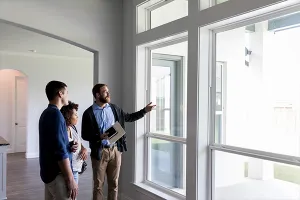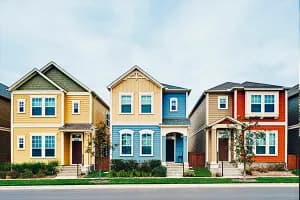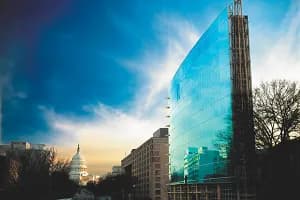When Jennifer Cullen and her husband, Randy, finally got around to downsizing last year, they began looking for a home in an area with as many amenities as possible. “We definitely wanted a walkable neighborhood,” said Jennifer, a 68-year-old former nurse who has worked with First Weber as a referral agent in recent years. Her 74-year-old spouse is a retired doctor.
The couple is hardly alone. From young singles and couples, to families in their 30s and 40s with kids, continuing on up to seniors, studies show that living in neighborhoods with sidewalks that lead to parks, cafes, theaters, grocery stores, hiking trails and other amenities is not only desirable but good for residents’ mental and physical health, too.
Amenities are places where communities can come together regardless of age, background and world view.
Edna Ely-Ledesma, an assistant professor in the Department of Planning and Landscape Architecture at the University of Wisconsin-Madison, said every age group—especially youngsters and seniors—can benefit from community amenities. “The most vulnerable population groups in society are typically children and the elderly, therefore planning for these groups is a critical aspect of public health,” she said. “Both groups benefit greatly from access to very similar amenities. Parks that have comfortable sitting areas and playgrounds with access to shade are some of the most inclusive amenities for these two groups.”

She defines amenities as “places where communities can come together and join in civil discourse, regardless of age, background and world view. The benefits that they bring, though sometimes intangible, always enrich the quality of life and attractiveness of cities. And in a civil society, everyone should have equitable [and free] access to amenities such as parks and libraries, with civic health being a primary benefit of public space in towns and cities.
Ely-Ledesman said the COVID-19 pandemic was a game changer in 21st-century planning trends. “The need to socially distance while being able to access amenities in cities forced and deepened our recognition of their public health benefits, especially open-air ones. This renaissance of parks in cities has enriched our understanding of amenities as critical assets to our civic health.”
“The National Community and Transportation Preferences Survey,” a report issued in 2023 by the NATIONAL ASSOCIATION OF REALTORS® (NAR) said that communities filled with experiences and places to access nature in parks and via trails—as well as shops, eateries and nightlife—often are sought out by people when they are looking for a place to live. Not only do they find it enriching to be near all these attributes, but they report that living in a walkable community is more time-efficient, cost-efficient and healthier due to all that strolling. From the Gen Z cohort in their 20s to the boomers in their 60s and 70s, each of these benefits can have a pronounced resonance at different stages of life.
According to the survey, half of residents in the top 50 metropolitan areas live in the suburbs and another quarter in residential parts of cities. A majority live in detached homes, with sidewalks, parks and public transit nearby. Just under two-thirds live in at least somewhat walkable communities.
Gen Z (those born from 1997 to 2012 and the children of younger baby boomers) and millennials (people born from 1981 to 1996) are more likely to agree that they want sidewalks on most streets and lots of places such as shops, cafes and restaurants to walk to.
Living in a walkable community is linked to what people say is a higher quality of life, with half of those who live in a highly walkable community reporting that they are very satisfied with their quality of life, the survey said. The importance of walkability is also strongly correlated with generation, with half of millennials seeing it as quite important.
Gen Z and millennials also prioritize proximity to public transit more highly than closeness to the highway. Urban residents are much more likely to say proximity to amenities is very important. Walkable communities, short commutes, proximity to public transit are all very important to a plurality of city dwellers, the report said. Suburban and rural residents are similar to each other in assigning lower importance to public transit, commute distance and walkable distance to community places.

Suburban residents are more like urbanites when it comes to having sidewalks, with half saying it is very important. About six out of 10 residents would spend at least a little more for a house in a walkable community—similar to results in previous polls.
The study said there is a direct correlation between generation and the willingness to spend more for walkability. Among those who say walkability is important, roughly 90 percent of Gen Z and millennials say they would pay more to live in a walkable community, with one-third saying they would pay a lot more.
Americans lean toward more walkable communities when compared to different options that require more driving. A larger majority—compared to other years—prefer a walkable community with a smaller yard, but just under half prefer a larger yard and more driving.
In an uptick from previous years, half of all respondents said they prefer a walkable community and shorter commute time even if it means living in an attached home. When the only trade-off for the walkable community is a smaller yard, just over half of all residents prefer that option, with 56 percent overall preferring the more walkable community.
Gen Xers (those born from 1965 to 1980) especially those with kids at home, lean towards larger homes and more driving. Millennials with kids at home, however, would like to live in a walkable community, when the only tradeoff is a smaller yard.
Generation plays an important role in separating residents. Gen Zers and millennials are more likely to prefer an apartment or townhouse with walkability and a short commute. Gen Xers and boomers are more likely to lean toward a detached single-family home.
The report also said most residents like walking (79 percent) and driving (70 percent), while about half say they enjoy riding a bike, and slightly fewer (44 percent) say they like taking public transit like trains and buses—an uptick from previous years. Age is also a key consideration in these preferences. Younger generations are more likely to like biking and taking public transit, while older generations are more likely to say they enjoy driving.
Another report, the “America At Home Study,” surveyed 10,000 consumers before, during and after the pandemic about their housing and neighborhood desires. Results from the study’s Third Wave, released in 2023, showed that while there are generational differences, the most significant gap may be between families with kids and couples and singles without children.
“Developers need to plan more amenities for this household type going forward, and that includes fewer traditional amenities like clubhouses and pools, and more places to connect and gather with others like coffee shops,” wrote Teri Slavik-Tsuyuki, co-founder of the America At Home Study, principal of “tst ink” and chair of the Global Wellness Institute’s Wellness Communities & Real Estate Initiative.
This is in addition to amenities like trails, bike paths, fitness spaces and things that support overall wellbeing, which is a “huge purchase motivator for singles and couples of all ages,” added Slavik-Tsuyuki. “As family formations have changed, the level of importance on places to meet and to connect socially has increased.”
Chris Fernandez, director of planning at DAHLIN Architecture and partner of the survey, said nature and open space can be the determining factor when choosing one community over another. “The days of parks and open spaces being the leftover piece of land or an odd-shaped inefficient part of the site no longer is acceptable. The location and functionality of parks and open spaces needs to be intentional and inter-connected.”

These spaces need to vary in size, offering both passive and active uses. Rather than trying to accomplish all the needs of the community in one place, offering a series of parks and open spaces is desired. “Although a large percentage of people want a large park with open fields, it is also important to provide small, quaint and quiet spaces for people to relax as well. Being adjacent to a lot of activity is not always desirable,” he said.
Fernandez said trails, parks and open spaces of all kinds are extremely important to respondents’ sense of wellbeing. “The survey showed that ‘Mental Wellness and Engagement’ was ranked as very important to 85 percent of respondents… and yet only 66 percent said they were satisfied with their own level of personal mental wellness—a gap of 19 percent.

Parks, trails, and open spaces at an accessible distance can greatly impact mental health.
“This is concerning, as the level of importance people place on mental wellness increased every time that we tested it in three waves from 2020-2022,” Fernandez said. “People want to be more connected with nature and knowing that they have parks, trails, and open spaces at an accessible distance can greatly impact mental health. This is something important that DAHLIN keeps at the forefront of its designs.”

Slavik-Tsuyuki said towns and cities should focus on wellness when they plan amenities in the future. “Wellness is the new ‘why,’” she said. “Ways to encourage people to get outside and connect, to move more physically, to experience social connections with other people, to experience casual conversations and breaks in the day, are reasons to get out in the local community.
“The increased demand for coffee shops and casual ‘third places’ to meet with others, to take a business call or to get a break from the house has increased and stayed strong now that up to 30 percent of all U.S. adults are working some or all the time from home. Coffee shops rank even higher than pools, clubhouses and gym/fitness facilities in the survey.
“Today, families with kids make up less and less of the population (3-person households are 15 percent and 4-person households are 13 percent) which leads to traditional ‘family’ amenities having less appeal for singles and couples.
“There is a need for smaller scale walkable places for casual play like a small field to throw a ball, or play with a dog, or meet neighbors and visit. These need to be throughout the community, not just as part of a giant over-programming community amenity and clubhouse across fast, divided roads that aren’t safe to walk to.”
The Cullens, who are definitely boomers, had lived for nearly a decade in rural Dane County, Wis., in a 4,200-square-foot house. And as much as they enjoyed their wooded, rural setting, the location about eight miles west of Madison meant they had to drive pretty much everywhere. And because there were no sidewalks on the roads, going on a stroll with their dogs with cars swooshing along at 45 miles per hour often felt perilous.
“It was kind of overwhelming,” said Jennifer. “But we needed to do this move, in part, to finally force ourselves to go through several generations worth of items that we had in our larger home. Our parents had died, so we had a lot of their belongings. Then we had our respective things from growing up ourselves, and we had stuff that our kids had stored there.
“We just had such a hard time getting to it. It was a constant goal, but for a long while, we couldn’t make ourselves do it,” she admitted.
That delayed things. But they also knew they wanted a house with a primary bedroom on the main floor “so we could be in a place where we could, ideally, stay for the rest of our lives. Not that we can’t handle stairs now, but we didn’t want to wait until we could no longer do them.”
Their new abode, which was built in 1953 and is around 2,300 square feet, is in a popular neighborhood on the northwest side of Madison. The house is just a short walk from a nature conservancy, an expansive, 500-acre nature preserve with hiking trails, a creek, grasslands, trees, a bubbling spring and a hill with Native American effigy mounds. It also offers panoramic views of the Madison skyline and the state capitol building.
“I knew that we would enjoy living close to the conservancy, but that has probably proved to be Randy’s most favorite part of this move, just being able to walk the dogs down on those trails, which are very near us. Once you’re there, you don’t feel like you’re in the city at all.
“We can also walk to restaurants and pubs. The pharmacy is practically around the corner, and I can also stroll to a local co-op for groceries.” In addition, the community swimming pool and a performing arts center are close by for when grandchildren visit.
“There are a lot of reasons we like being here, not only because of the walkability, but the neighbors have also been really welcoming and friendly. Plus, the mortgage is smaller, and we don’t have such a big yard to care for anymore,” she said. “There’s a lot less to manage here, so if one of us were left alone—and you have to think about that as you get older—I’m pretty sure either one of us could manage being here on their own.”
Out on the West Coast, Seattle-based Mike McGinn, executive director of America Walks, said the ability to go on foot or ride a bike to activities “is really important for a host of reasons for all ages, including safety, health, environment and the local economy.
“But probably most important is community because people who live in a walkable or very walkable area have a much stronger feeling of connection with their neighbors as well, which is good for your mental health,” said McGinn, a former mayor of Seattle, environmental advocate and state Sierra Club director.
“It kind of speaks to who we are because walking is the oldest form of transportation. We are designed to walk and we’re meant to be in a community with other people. Walkability means independence for all age groups. Many of us have fond memories of walking to school, a choice denied to many kids today,” explained McGinn.
He said having parks, ballfields, grocery stores, cafes, restaurants, swimming pools and theaters nearby clearly makes neighborhoods more attractive and valuable, for the young and old alike. “Often, trips of a half mile or less can be fastest by walking because you don’t need to deal with a car, parking and things like that. But you need infrastructure to walk, which is why safe sidewalks that lead to destinations are so important.”
McGinn, who grew up in a walkable neighborhood on Long Island, said what we’ve been seeing in the last couple of decades is a rediscovery of the neighborhood and then reinvesting in downtowns because they are actually a really nice place to live.
Fortunately, modern planners are again designing or redesigning neighborhoods around transit stops. So, businesses naturally spring up there, because that is where people are coming and going. “My old neighborhood was built in the 20s and 30s, and I lived about a seven-minute walk from the Long Island Railroad station.
“On my street there were single-family houses and at the top of the block were garden apartment houses. Then on the waterfront, there were mansions, so it was definitely a mixed neighborhood.”
McGinn said it isn’t just small towns or urban neighborhoods built 100 years ago that can be walkable and filled with amenities. “Suburbs absolutely can be designed that way. And they should for a wide variety of reasons, including because that’s what people want. We just got away from that in our car-centric culture. But we can do better.”
In Maryland, Christie Ciabotti, Montgomery County’s division chief for park planning and stewardship, said her agency’s five-year Parks, Recreation and Open Space (PROS) plan takes the desires of different age groups into consideration.
“We did a really extensive public outreach effort as part of PROS in order to learn what the community was feeling about parks and how they interact with parks. We learned a lot of interesting stuff, including that the senior population in our county is rising. Back in 1960, most of the households were married couples with children, but that has changed a lot over time.”
The county has 419 parks and most of them have playgrounds. “We’re certainly going to continue to take care of our playgrounds, but what we’re really trying to focus on in this five-year plan is how to provide more active recreation and social connection for teens, working-age adults and seniors,” she said.
She explained while skate parks are popular with boys and young men, the surveys showed they didn’t appeal to that many girls. “We will be building five to seven skate parks in the next few years to meet that growing need, but what girls say they want are places to hang out with their friends, like on swings.
“And it turns out that everyone likes swings, seniors, too,” she said with a chuckle. “We also want to make sure parks feel safe and welcoming for teens.
“But while we can think about targeting amenities for specific age groups, actually everyone uses most of them. And as for that growing group of seniors, they don’t necessarily want to use ones that are specifically targeted for them.”
She said the county’s parks have outdoor fitness equipment sites that are popular with seniors and others, and the parks department has something called the Program Access Group, which does walking and fitness events for older adults. “And, recently, we participated in a ‘Summit On Aging’ here in Montgomery County.”
To learn what county residents want, public outreach specialist Michelle Ramirez explained that the parks department used a robust set of tools, including online surveys, newsletters, Open Town Halls and emails to homeowners associations. “We wanted to spread the net far and wide to reach people in addition to those already engaged with Montgomery County parks. We held activation events and partnered with community organizations and non-governmental organizations to reach different demographics.
“We also take surveys to schools, whether that’s emailing it to a PTA or going into the school and actually asking the kids the questions. And we’ve done door-to-door canvassing, using whatever language is dominant in a specific neighborhood, as well as community meetings that are both virtual and hybrid to reach as many people as possible.” Montgomery County focused on being all-inclusive in its information gathering to ensure they reached families, singles, all age groups and diverse residents so that the needs and wants of all residents are planned for and met.
Across the country, community amenities are extremely important for all ages and demographics, and planners are rethinking neighborhood design to accommodate everyone at any point in life.













